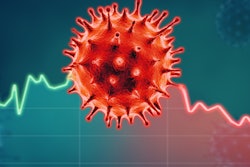
It's possible for radiology practices to "recover wisely" to pre-COVID-19 imaging volumes, according to a study published August 10 in Academic Radiology. It comes down to close monitoring of data, researchers believe.
"To [recover wisely], we used a data-driven approach to inform our decisions and strategies," noted the team, led by Dr. Achala Vagal of the University of Cincinnati. "Provision of a safe environment for patients and staff remained our top priority."
The COVID-19 pandemic prompted declines in imaging volume of at least 50% as imaging centers and hospitals postponed nonemergency exams. Procedure volume has only slowly started to come back since then.
At the University of Cincinnati, Vagal and colleagues launched an initiative for reinstating nonurgent imaging on May 4. The team used the Standards for Quality Improvement Reporting Excellence (SQUIRE) 2.0 guidelines -- a structure for reporting knowledge about improving healthcare -- to assess imaging volumes over a 10-week period (May 4 to July 10) in an effort to restore them to pre-COVID-19 levels, including addressing exam backlogs.
The strategy included establishing a task force that consisted of radiologists, administrators, technologists, and schedulers. The group gathered imaging information by date, time of day, site, modality, and available scanners and used this data to model the recovery program.
"We continuously monitored the backlog of imaging studies and available imaging resources as we gradually opened imaging sites," Vagal and colleagues wrote. "A thorough and real-time evaluation of our backlog, vis-à-vis resources, ensured 'equity in prioritization' for all referring physicians and specialties."
The strategy consisted of the following:
- Phase 1 (week 1): Backlog patient list prioritization
- Phase 2 (weeks two and three): Scheduling prioritization; developing a dashboard to report recovery progress; and opening additional facilities to handle backlog
- Phase 3 (weeks four through 10): All facilities open with normal hours; two outpatient centers with extended hours. Screening exams have resumed, as have nonessential research studies. Continued focus on communication of available services to patients and referring physicians
"Although the pandemic is an unprecedented crisis, it provides a unique opportunity for us to rethink our healthcare operations and create radically different care models for the 'new normal,'" the group wrote.
The plan succeeded in achieving overall outpatient imaging volume recovery by 102% by week 10 compared with average weekly pre-COVID-19 outpatient volumes. Outpatient volumes by modality recovered in the following rates:
| Impact of recovery program on post-COVID-19 imaging volumes | |
| Nuclear medicine and PET | 138% |
| CT | 113% |
| Interventional radiology | 106% |
| MRI | 101% |
| Ultrasound | 99% |
| Mammography | 97% |
The authors concluded that it's definitely possible for practices to recover to pre-COVID-19 imaging volumes.
"The COVID-19 crisis has called for a reimagination of places, people, and strategies for healthcare organizations to prepare for the postpandemic phase," they wrote. "In this recovery process, we learned important lessons of effective, tailored communications, cross disciplinary teamwork, and innovative solutions."



















